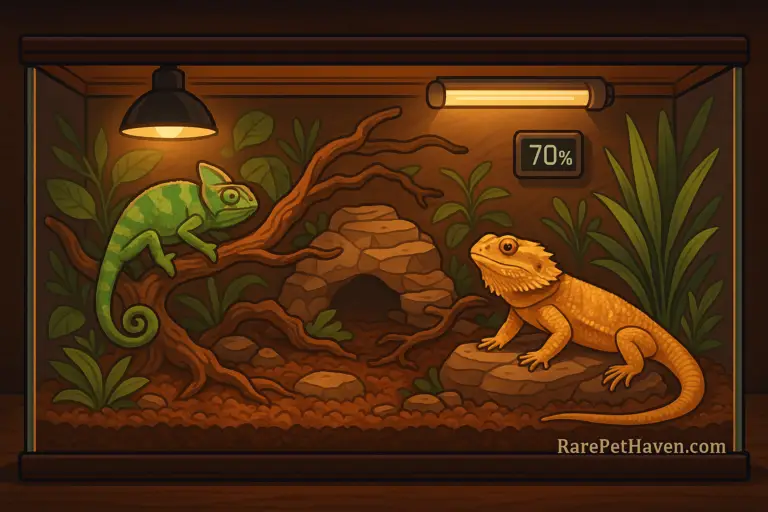
Table of Contents
Creating a vivarium that’s both functional and natural-looking is one of the most rewarding aspects of keeping a reptile. But a vivarium isn’t just about making your pet’s space look cool—it’s about mimicking their natural environment so they can thrive physically and mentally.
In this complete beginner’s guide from Rare Pet Haven, we’ll show you how to set up the perfect vivarium for reptiles—including expert tips on lighting, humidity, substrate, and decor.
What Is a Vivarium?
A vivarium is a fully enclosed habitat designed to recreate the natural conditions needed by reptiles, amphibians, or even insects. It balances temperature, humidity, light, and decor to provide a stable, enriching home.
Vivarium vs. Terrarium vs. Aquarium
-
Vivarium: Life-supporting system with heating, lighting, and humidity controls.
-
Terrarium: Often used for dry, desert-like reptiles or decorative plants.
-
Aquarium: Primarily water-based environments (for aquatic reptiles or fish).
Choosing the Right Size and Style
Arboreal vs. Terrestrial Enclosures
Arboreal reptiles (like chameleons or green tree pythons) need vertical space with climbing branches.
Terrestrial reptiles (like leopard geckos or tortoises) require floor space and ground-level hides.
Glass, PVC, or Wood?
Glass tanks: Easy to find, great visibility, but poor insulation.
PVC enclosures: Durable, lightweight, and hold heat well—perfect for most reptiles.
Wood vivariums: Great insulation, but must be sealed to resist moisture.
Essential Vivarium Lighting
Lighting is critical to a reptile’s health—especially for digestion, mood, and vitamin D3 synthesis.
UVB vs. UVA
UVB is needed for calcium absorption and prevents metabolic bone disease.
UVA helps regulate behavior and mood.
Not all reptiles need UVB (e.g., nocturnal species), but many diurnal ones do.
Basking Lamps & Heat Gradients
Use a basking bulb to create a temperature gradient (warm side and cool side).
Monitor with infrared thermometers and digital thermometers.
Photoperiod Tips
Most reptiles need 10–12 hours of light per day.
Use timers to maintain consistent day-night cycles.
Humidity Control & Misting Systems
Humidity is just as important as temperature for reptiles, especially amphibious or tropical species.
Hygrometer Setup
Install a digital hygrometer on both sides of the vivarium to monitor moisture levels accurately.
Manual vs. Automatic Misting
Manual spraying works, but automated misters or foggers offer consistency.
Some species require daily misting; others only once a week.
Species-Specific Needs
Crested geckos: 60–80% humidity
Bearded dragons: 20–40% (dry climate)
Chameleons: 70–100% with misting twice daily
Best Substrates for Reptiles
Choosing the right substrate ensures cleanliness, comfort, and humidity control.
Bioactive Substrate Layers
Bioactive setups support natural behavior and help self-clean:
Drainage layer (e.g., LECA)
Mesh screen
Organic soil mix with leaf litter
Clean-up crew: isopods & springtails
Loose vs. Solid Bedding
Loose substrates (like coconut fiber) are great for burrowing species but may pose ingestion risks.
Solid substrates (like tile or reptile carpet) are easier to clean and safer for some species.
Cleaning & Maintenance
Spot clean daily (remove waste)
Deep clean monthly
Replace substrate every 3–6 months (or as needed)
Vivarium Decor That Feels Like Home
Hides, Rocks, Branches, Plants
-
Every reptile needs at least two hides (warm & cool side).
-
Add climbing branches, basking rocks, and secure perches.
-
Use silk or live plants to reduce stress and increase humidity.
Safe vs. Unsafe Materials
-
Safe: Cork bark, grapevine wood, reptile-safe faux plants
-
Avoid: Cedar, pine, painted wood, sharp-edged decor
❌ Common Vivarium Mistakes to Avoid
Poor Ventilation
Ensure air flow to prevent mold and respiratory issues. Cross-ventilation is key!
Incorrect Temperature Zones
Avoid heating the whole enclosure evenly. Reptiles thermoregulate by moving between warm and cool areas.
❓ FAQs – Vivarium Setup for Reptiles
Can I use real plants?
Yes! Just ensure they’re non-toxic and pesticide-free. Live plants also boost humidity.
Do all reptiles need UVB?
No. Nocturnal species may not require UVB, but diurnal species like iguanas and bearded dragons do.
How often should I clean the vivarium?
Spot clean daily, deep clean every 4 weeks, and refresh substrate every 2–3 months.
What’s the ideal humidity level?
It depends on the species. Desert reptiles: 20–40%. Tropical reptiles: 60–90%.
What decor is unsafe for reptiles?
Avoid painted materials, sharp rocks, or chemically treated wood.
Can I keep more than one reptile in a vivarium?
Only if the species is non-territorial and thrives in groups (like some anoles or mourning geckos).
🐾 Conclusion – Create a Safe, Natural World for Your Reptile
A well-set-up vivarium isn’t just a habitat—it’s a slice of the wild. With the right lighting, humidity, substrate, and decor, you’re giving your reptile a chance to thrive in comfort and safety.
Explore more detailed care guides and vivarium build tutorials here on Rare Pet Haven, your go-to hub for responsible, enriching exotic pet ownership.